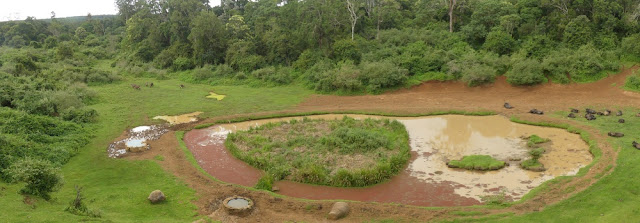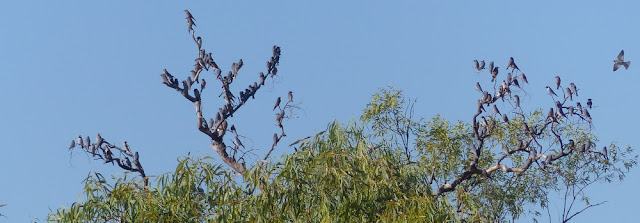This post continues a now well-established tradition of mine of posting on the last day of the year, aiming to offer one photo taken each month of the year as a way of celebrating the year that has gone. Sadly, for the second year in a row, about the only thing to celebrate about 2021 is that it's nearly over. We should never feel like that - life is too transient to wish away, but it's a bit hard to avoid these days. In addition to the obvious COVID pall it's been a very sad one for us in personal ways, but so it has been for many others too. One spin-off of these things is that I took relatively few photos - in other years I've struggled to decide what to leave out, but not this time. However there was only one month where I actually had no photos to choose from, and in that case I've 'borrowed' from a previous month. (My blog, I make the rules! :-) )
The long drought had finally broken in mid-2020, and we swung into the wet La Niña phase of the climatic cycle, so it was generally rainy and cool and the bush responded well to it.
Travel was of course very restricted - some of the time we couldn't leave the immediate environs of our suburb - but we managed one trip early in the year to South Australia to attend a family wedding deferred from last year, a couple of fleeting trips to the nearby south coast, one to the Blue Mountains, and a week in western New South Wales when things opened up a bit. As a result more of these than usual were taken in the ACT, mostly close to home. However it was the year that it was, and here's my version of it.
(As ever I don't make any pretence to photographic excellence, but have chosen the pictures because of their associations, and in most cases because they are ones I've not previously used this year in a blog posting.)
JANUARY
FEBRUARY
 |
| And a second one from February, an Eastern Bristlebird Dasyornis brachypterus, at Currarong, south coast NSW. This is our favourite coastal destination, on the north end of Jervis Bay (more about it here), and this bird is nationally Endangered, with perhaps only 2000 left in coastal heathlands. The Currarong area is a stronghold and an early morning walk will usually produce a couple, but this is the closest I've ever been to one, and the only decent photo of one I've ever taken. A highlight of the year. |
MARCH
In March we made our only interstate trip, as mentioned above. On our way back from Adelaide we camped a couple of nights in the wonderful Gluepot Reserve (run by Birds Australia) in the mallee country of South Australia (more on it here). It was still suffering from drought and the special mallee birds weren't much in evidence, but we had it to ourselves and we enjoyed our time.
 |
| I like this snap of 'our' gecko, an Eastern Tree Dtella Gehyra versicolor which ventured out of an empty pipe by the toilet block at night. |
APRIL
April was still a window of relative calm and freedom of movement before the doors, quite properly, slammed shut again. We took the opportunity to spend a few days in the Blue Mountains to check the autumn flowers, and as compensation for being prevented from going there for Christmas. But there we made a very exciting discovery.
MAY
By May things were starting to shut down but we did some local walks, including one along the Murrumbidgee River at Casuarina Sands, not far from here. In March there had been major flooding across New South Wales, and while the ACT wasn't impacted as far as loss of life or property was concerned, the local rivers well overflowed their banks. We got over 160mm of rain for the month, compared with the long-term average of 54mm and our walk came with some dramatic reminders of this.
JUNE
June was a very bad month for us at a personal level, and the camera remained in its bag for the duration. Here's one from the Blue Mountains a couple of months earlier to fill the void.
 |
| Golden Scalycap Fungi Pholiota aurivella, Coachwood Glen, Megalong Valley, Blue Mountains. A memory of a lovely walk in cool temperate Coachwood rainforest. |
JULY
Here we managed a much-needed couple of days at the coast. It was a time of quiet reflection and easy walks. We spent some time watching this engaging Echidna in a quiet coastal village street, pottering in people's front yards. It was a delightful interlude.
 |
AUGUST
In August the National Botanic Gardens finally reopened to visitors (they closed and reopened several times) and we'd probably never valued so much the opportunity to stroll there.
 |
| A highlight was watching this magnificent male Satin Bowerbird Ptilonorhynchus violaceus snacking on the luscious fruits of Lilly Pilly Amena smithii, a common small tree of coastal rainforest edges. |
SEPTEMBER
For what at least seemed like quite a while we couldn't leave our 'region' of Canberra, or exercise with friends. Finally in September, as spring was exploding, we could again walk with another person and I enjoyed a morning walk nearby with my friend Chris, exchanging thoughts and enjoying the views and birds.
OCTOBER
Finally in October we could travel without restriction within the ACT (and local parts of New South Wales, but not elsewhere). For some time there had been regular reports of an uncommon visitor to the ACT at Campbell Park across town, and I had been very much hoping that it would wait until I could visit it!
NOVEMBER
In November we finally managed to leave Canberra to take a short trip to western New South Wales, specifically to see the River Darling flowing strongly after a string of dry years. It was a welcome escape, though the weather wasn't kind and we didn't see as much as we'd hoped. Nonetheless we were very grateful for the opportunity. The picture I chose for the month isn't one I expected to choose as a memento of the month though.
DECEMBER
In December we again had a few days at Currarong, this time for Lou's special birthday. One day we went to a nearby village to look at a coastal lagoon, then had coffee sitting outside a cafe in a fairly uninspiring row of shops near a busy road. The whole experience changed though when a small flock of Figbirds Sphecotheres vieilloti appeared in a street tree by us and proceeded to sing cheerfully.
I love to receive your comments and in future will be notifying you personally by email when a new posting appears, if you'd like me to. All current subscribers have been added to this mailing list and have already been contacted.
This will mean one email every three weeks at the current rate of posting.
Should you wish to be added to it, just send me an email at calochilus51@internode.on.net.
You can ask to be removed from the list at any time,
or could simply mark an email as Spam, so you won't see future ones.




















































